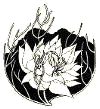
Home
Mission
Overview of Project
Project Staff
Sponsors
Achievements
Checking, Illustrations
Upcoming Activities
Id and Species Lists
Protea Information
Protea Gallery
Growing Proteas
Interim Dist. Maps
Publications
Afrikaanse Inligting
![]()
Leaf Predation
 Reports on predation of Proteaceae leaves are very interesting. Derek Clark,
who compiled a list of foodplants of buck in the Cape of Good Hope Nature
Reserve, found that buck never fed on Proteaceae leaves. Apparently this is
because the hard, woody leaves have a very high carbon to nitrogen ratio:
consequently, animals feeding on these plants cannot manufacture sufficient
quantities of protein (for which they require the nitrogen) and the carbon
merely fills the gut impeding the utilization of other material. This applies to
small animals such as caterpillars far more than to large buck, which can
readily accommodate vast quantities of leaves. CB Cottrell has used this theory
to explain the lack of butterflies in Fynbos. In fact, most of the butterfly
species in Fynbos behave like the myrmecochorous fruit of the Proteaceae, and
live in ant's nests. Unlike Proteaceae fruit, however, they either consume
high-protein ants or make use of them for protection (see PAN 6: 13).
Reports on predation of Proteaceae leaves are very interesting. Derek Clark,
who compiled a list of foodplants of buck in the Cape of Good Hope Nature
Reserve, found that buck never fed on Proteaceae leaves. Apparently this is
because the hard, woody leaves have a very high carbon to nitrogen ratio:
consequently, animals feeding on these plants cannot manufacture sufficient
quantities of protein (for which they require the nitrogen) and the carbon
merely fills the gut impeding the utilization of other material. This applies to
small animals such as caterpillars far more than to large buck, which can
readily accommodate vast quantities of leaves. CB Cottrell has used this theory
to explain the lack of butterflies in Fynbos. In fact, most of the butterfly
species in Fynbos behave like the myrmecochorous fruit of the Proteaceae, and
live in ant's nests. Unlike Proteaceae fruit, however, they either consume
high-protein ants or make use of them for protection (see PAN 6: 13).
This poses a little problem for Proteaceae plants. When the leaves are small, succulent and expanding they are filled with nitrogen and a good food-source. They have to grow quickly and expand to full-size, before the woody materials characterizing the hard, rigid "sclerophyllous leaves", can be deposited. Once at full-size, the leaves are not only unsuitable for eating, but can withstand extreme dessication with minimal damage. In contrast, young leaves are often covered with hairs (to clog up insect mouthparts and reduce evaporation); are a different colour to adult leaves (red or yellow to make leaves inconspicuous to insects and reduce heat loading); and usually have active nectaries which secrete nectar (to cool the leaf and attract ants and parasitic wasps and flies). Thus plants must choose the time of year which will allow them to expand their leaves so that they will not shrivel in the heat or be consumed by insects. Atlassers may collect data on the status of new leaves for the Proteaceae they record. This will give scientists a clue as to just how important dessication and predation are for these plants.
Please note that the huge circles missing in mature leaves were probably made by small insects when the leaves were tiny. Like the leaf, these `bites' expand and may end up far larger than their creators.
As always, there are exceptions: even to the rule that Proteaceae leaves are unpalatable. Plants growing on nutrient-rich soils may produce leaves with a higher nitrogen content and thus lower carbon to nitrogen ratios: these plants may be grazed by buck, cow and caterpillar alike. One such plant is the very rare Protea odorata Swartland shale protea, the smallest of our Proteas, which, in addition to a variety of factors contributing to its decline, is browsed by cattle.
We welcome your observations on such predation, especially if you can provide the name of the browsers involved. You may be able to have insects identified by your local museum. Alternatively, the Fynbos Research Unit, Vegetable and Ornamental Plant Research Institute (Private Bag, ELSENBERG, 7607) is compiling a list of pests to Proteaceae and may be able to identify them for you.
Back PAN 8